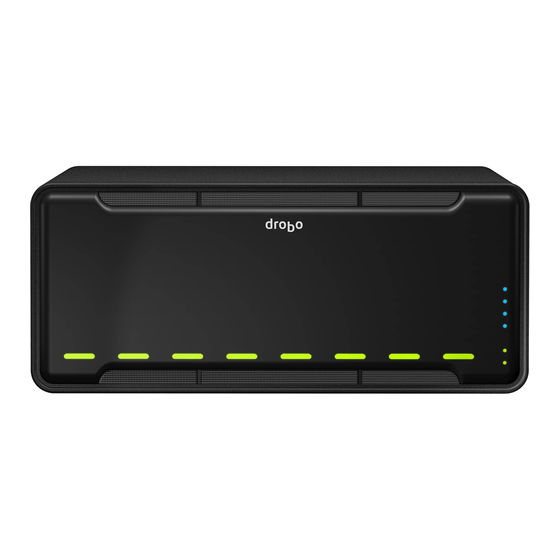
Advertisement
Quick Links
Download this manual
See also:
Manual
Configure Windows iSCSI Multipath I/O (MPIO) with Drobo iSCSI SAN
Multipath I/O (MPIO) enables the use of multiple iSCSI ports on a
Drobo SAN to provide fault tolerance. MPIO can also boost
performance of an application by load balancing traffic across
multiple ports. This guide provides the steps to easily configure
MPIO to Drobo iSCSI storage for a Windows server. See the Drobo
B1200i iSCSI SAN at top right and the
Drobo B800i at the bottom right.
Microsoft Windows Server 2008 natively supports a wide array of MPIO
configuration scenarios. These policies can be configured on a per-volume basis
to provide granular control of how Drobo SAN bandwidth is utilized. The figure
below illustrates three of the most common multipathing configurations.
Topics
What you will need & Prerequisites
Provisioning Drobo storage
Disabling Drobo Dashboard on MPIO-enabled hosts
Enabling Windows MPIO support
Gathering Drobo configuration details
Configuring MPIO
Selecting a routing policy
What You Will Need
•
Drobo iSCSI SAN storage system: B1200i or B800i, updated to the current firmware version
•
Drobo Dashboard management software, updated to the current software version
•
Windows 2008 or 2008 R2 Server
•
Ethernet network(s)
Drobo How-To Guide
drobo.com | Configure Windows iSCSI Multipath I/O (MPIO) with Drobo iSCSI SAN
1
Advertisement

Summary of Contents for Drobo iSCSI SAN
-
Page 1: What You Will Need
Selecting a routing policy What You Will Need • Drobo iSCSI SAN storage system: B1200i or B800i, updated to the current firmware version • Drobo Dashboard management software, updated to the current software version • Windows 2008 or 2008 R2 Server •... - Page 2 Configure Windows iSCSI Multipath I/O (MPIO) with Drobo iSCSI SAN Prerequisites This document assumes that the Drobo iSCSI SAN has been deployed and Drobo Dashboard has been installed on all hosts to enable MPIO. Drobo Dashboard should be installed on a management server or workstation that will not use MPIO.
- Page 3 Because the Drobo is thinly provisioned, you can configure a volume greater than the size of the available physical storage. drobo.com | Configure Windows iSCSI Multipath I/O (MPIO) with Drobo iSCSI SAN...
- Page 4 Apply. The Drobo storage is now provisioned but should not be mounted from Drobo Dashboard. To configure MPIO, the volume must be mounted manually from the iSCSI initiator. drobo.com | Configure Windows iSCSI Multipath I/O (MPIO) with Drobo iSCSI SAN...
- Page 5 Drobo Dashboard typically handles all aspects of provisioning and mapping storage on Windows hosts. During installation it also modifies a number of registry settings to optimize iSCSI performance with the Drobo SAN. On MPIO-enabled hosts, the Dashboard’s fault monitoring can interfere with manually configured initiator settings.
- Page 6 The Drobo Dashboard service is now disabled and should not enabled on the host. Management of the Drobo must now be performed from a management server, workstation, or any non-clustered host. drobo.com | Configure Windows iSCSI Multipath I/O (MPIO) with Drobo iSCSI SAN...
- Page 7 MPIO support is not enabled by default. In the Select Features screen, select the Multipath I/O check box to install MPIO. Click Next and then Install to complete the wizard. drobo.com | Configure Windows iSCSI Multipath I/O (MPIO) with Drobo iSCSI SAN...
- Page 8 Discover Multi-Paths tab, click the Add support for iSCSI devices check box and click OK. A reboot may be required to complete the process. If prompted to reboot, click OK. drobo.com | Configure Windows iSCSI Multipath I/O (MPIO) with Drobo iSCSI SAN...
- Page 9 Make a note of the Target Name for the newly created volume displayed in the FileShares screen, as it will be referenced throughout this document. drobo.com | Configure Windows iSCSI Multipath I/O (MPIO) with Drobo iSCSI SAN...
-
Page 10: Configuring Mpio
IP address or DNS name field and verify the port is set to 3260. Click OK and repeat the process for all Drobo iSCSI IP addresses. drobo.com | Configure Windows iSCSI Multipath I/O (MPIO) with Drobo iSCSI SAN... - Page 11 2. NOTE: There may be a large number of discovered targets, but modifying settings on the incorrect target name can degrade performance or result in iSCSI connectivity failures. drobo.com | Configure Windows iSCSI Multipath I/O (MPIO) with Drobo iSCSI SAN...
- Page 12 Repeat steps 4 - 6 for the remaining Drobo iSCSI IP addresses. Once all addresses have been connected, click OK to save changes and exit iSCSI initiator Properties. drobo.com | Configure Windows iSCSI Multipath I/O (MPIO) with Drobo iSCSI SAN...
- Page 13 Fail Over Only. No load balancing is performed. If the primary path fails, one of the available standby paths are • used. If the Drobo has more than two iSCSI paths, the standby paths will be selected based on a preference. The standby port with the highest preference will be used first.
- Page 14 1.866.97.DROBO Copyright 2012 Drobo, Inc. Data Robotics, Drobo, DroboEllite, DroboPro, BeyondRAID, and Smart Volumes are trademarks of Drobo, Inc., which may be registered in some jurisdictions. All other trademarks used are owned by their respective owners. Ÿ Ÿ All rights reserved. Specifications subject to change without notice.
















Need help?
Do you have a question about the iSCSI SAN and is the answer not in the manual?
Questions and answers